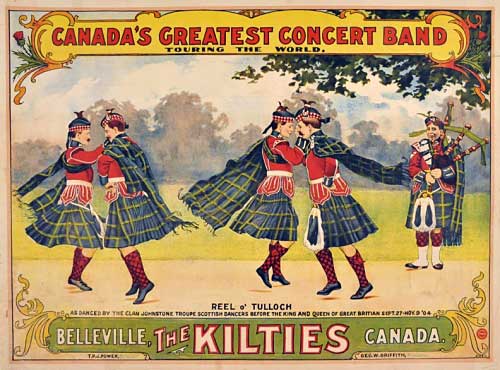By Jeannie Campbell

During that first British tour in 1904, Albert and the Kilties played for King Edward VII at Balmoral and a newspaper reporter in Dundee asked about the experience. “Yes,” he said, “the King was certainly pleased. … I piped and danced for Queen Victoria many a time. How she did love the piping and the dancing. I talk[ed] to the King? No, it wasn’t for me to push myself forward – not that I should have been a bit put out if I’d been spoken to. I’m too used to that sort of thing.”
The article, from the Dundee Evening Post, of October 3, gives a picture of the career of Albert and more about the visit to Balmoral:
“An Evening Post representative the other day had an interview with Pipe-Major Albert Johnstone, who for many years conducted dancing classes in Dundee and various towns in Forfarshire, Fifeshire, and Perthshire. Nine years ago the Pipe Major and his troupe made their first notable appearance at the Palace Theatre, London, and since then they have been growing in popularity and fame. Encomiums and tokens of appreciation were heaped upon them in their grand transcontinental tours of the United States, Canada, and Mexico. The troupe comprises two fleet-footed Dundee lassies, Cissie Grant and her sister, Katie Grant, and Tom Bowie, from the ‘Lang Toon’ of Kirkcaldy, and a strong rival to his master in the Terpsicorean art. The Pipe-Major plays the Scottish philabeg [sic!] with all the characteristics of a born piper, and the dancing troupe is a remarkable exhibition of the poetry and motion and a feat of pedal magic worth going miles to see.
“While conducting his classes in Scotland, Mr Johnstone acted as dancing tutor to the family of the Earl of Elgin. Becoming tired, however, of the routine work of maitre de dance, he decided to try his fortune in London, and selected the present troupe to accompany him. The troop speedily danced themselves [sic] into fame in the Metropolis, appearing not only at the principal music halls, but also at the Crystal Palace, the Alexandra Palace, and Earl’s Court Exhibition. The troupe afterwards accepted an offer to tour in the States, and the furore which their dancing created was such to attract the attention of Mr T. P. J. Power, the director of the Kilties, when they were performing at Jamestown, New York. He at once entered into negotiations with them to become connected with the famous band, and the troupe in consequence were compelled to cancel many of their engagements in England.
“The first tour occupied no fewer than 40 weeks, the troupe covering altogether 35,000 miles and performing at all the principal cities in every state. It was the longest and most successful band tour ever made in America. Another tour of America was opened at Buffalo in May last year, and the troupe danced before thousands of enthusiastic admirers in the grand Exposition Hall at the St Louis Exposition. They had a warm reception from almost every Scottish Clan Society in Canada and America, and have brought back many mementoes of their visit. They have danced before millionaires, have shaken hands with senators of America, and have had praise showered on them by every class.
Dancing at all times is hot work, but Pipe-Major Johnstone and his troupe had on one occasion to thankful for this fact. In Winnipeg they gave a performance when the thermometer stood at 40˚ below zero. The dancers warmed to their work, but the frost attacked the piper’s ear, and he felt more inclined to dance the Highland fling than nurse the philabeg.
“In the mining camps, where the lowest charge in some cases was two dollars for admission, the piping and dancing raised whoops of delight from patriotic Scotsmen. At Galveston, Cissie Grant, the principal dancer of the troupe, had a huge bouquet presented to her, and another occasion the Pipe-Major received a tribute consisting of a bunch of Scotland’s national emblem the thistle.
“‘In every hole and corner of Canada and the States’, said Mr Johnstone, ‘I met Dundee men, all of whom were in good circumstances. One of them came up to us when we were performing in a wooden shanty at Brisbee Mining Camp, Arizona, and presented Cissie with a souvenir in the shape of a good pin, the head being a small nugget of gold found in Denver, Colorado.’
“All the Dundee people they met had a longing to see Juteopolis and the Old Country, but they were unanimous in declaring that there was no place like Canada or the States for Scotsmen who wished to be successful in life.
“The recent reception by the King at Balmoral is naturally regarded by the troupe as the highest honour they have received, or can ever expect to receive. The ballroom in which they performed was tastefully draped with tartan and the members the Royal family who witnessed the performance were all attired in Highland dress. ‘It was like carrying coals to Newcastle to take me to Balmoral to play pipes before his Majesty, but (said the modest Pipe Major) the Royal audience seemed to thoroughly appreciate the march, strathspey and reel I rendered. When Tom performed the sword dance the King expressed his delight by shouting “Bravo,” and when the Irish jig was danced by the troupe in the costume of the colleens and Paddy at the Irish country fair, the King was so much impressed that he kept time with his hands and feet, and some appreciative remarks passed between his Majesty and the Prince of Wales.’
“… The present tour of the Kilties comprises many towns in England, Scotland and Ireland. Afterwards they journey to Paris, and on returning to the States the troupe contemplate a tour in Australia.”

The Band later received receiving a second command from the King, this time at Sandringham.
Albert Johnstone and Mary Jane Grant were married in Liverpool in June 1905 shortly before immigrating to Canada. The couple had one child, a daughter Kitty Grant Johnstone, born in Belleville on March 16, 1907. She became Mrs Kitty Grant Johnstone Lennox and died on December 19, 1992. Mary Jane’s brother, William Grant, a labourer with the Kilties, also immigrated and later enlisted in the Canadian Expeditionary Force in 1915, giving his sister as his next of kin.
The Kilties world tour was the most remarkable tour ever accomplished by any musical organisation in the world. During the touring years, the Kilties visited France, Australia, England, Scotland, Ireland, Wales, New Zealand, Italy, Egypt, India, Ceylon now Sri Lanka, Sicily, Spain, Burma, Tasmania, Fiji, Arabia, Hawaii and Mexico. Some tours took as long as two years before the group returned to Belleville, Ontario.
Power, the man who owned the Kilties was considered one of the ablest business managers in the amusement business on the American continent. The souvenir album commemorating their very successful World Tour was sold for a few cents before and after each performance. At Crystal Palace, London, the attendance was 170,000 paid admissions on the day; at Willow Grove Park, Philadelphia, the attendance reached 150,000 one day; at Madison Square, New York, the receipts for one day reached $7,000; while at the Coliseum in Chicago the receipts were over $4,000 for one day. In Sydney, Australia, the Town Hall that seats over 6,000 people was sold out solid for two weeks at high prices. The band was also the only one to have had the honour to be invited to play all its concerts in the ‘Million Dollar Festival Hall’ during the World’s Fair in St. Louis, Missouri, before a paying audience. All other bands representing other countries of the world played free of charge in the open.
Albert Johnstone and the Kilties visited Honolulu in Hawaii, arriving on July 24, 1908. Newspaper reports described Albert as the most famous piper in Scotland. The band paraded from the ship to the Opera House for their two performances and the next day departed for Australia. The band was in Britain again before it returned to the USA in 1910, sailing from Southampton on the Teutonic, and arriving in New York on July 29.
In the 1921 Census of Canada Albert (57) and Mary Jane (42), their daughter Kitty (14) and Mary Jane’s brother, William (28) lived at 74 Dundas Street, Hastings West in Belleville. By now, they had all retired from the entertainment business. Albert and Mary Jane’s occupation is listed in the Census as Teacher. William was a Piano Tuner.
Albert died on April 21, 1938 and was buried in Belleville cemetery. His occupation at the time of his death was stated as “Proprietor of Amusement Hall”.






